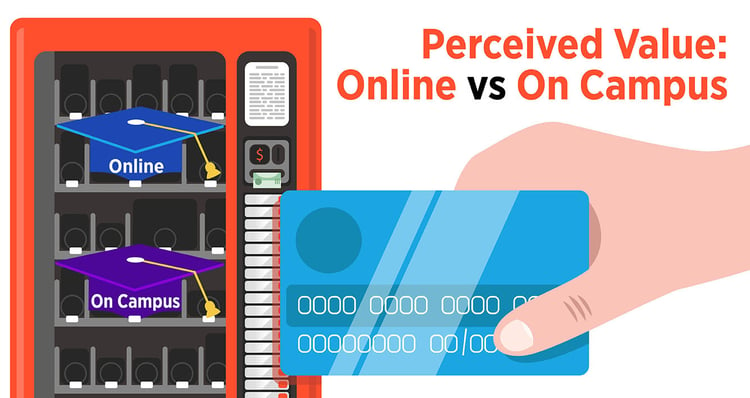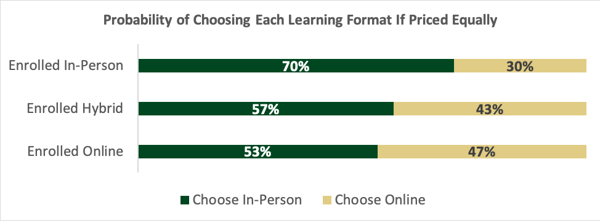
What are your students willing to pay for an online education?
Here is what you are really after: given your brand reputation, the demographics of your student cohort and the potential to create a new service delivery model, what should you offer and how much should you charge for it?
Let’s get that answered!
Our primary message: custom research into what your student cohort is willing to pay for your brand on campus or online is invaluable. An important part of innovation is the upfront market research that points your team in the right direction.
Below we review some new pricing research that offers insights and a conceptual approach to getting this type of data for your institution.
The context: During a high school Zoom graduation ceremony we watched this past week (my niece got her paper!), the valedictorian shared the experience of his last day in high school in March this year – a day like any other, except that at the end of it, the principal quite suddenly told everyone there would be no school the next day. A mundane day that suddenly marked the end of all he had worked for. No celebration, no Senior Week pranks, no high fives, just, head home and, as it turned out, don’t return.
His comment at the close of his valedictorian graduation speech: Don’t ever doubt that the world can change in an instant.
Across the globe, students and institutions shared that experience. How will all those valedictorians and all their friends make decisions going forward. College? Job? Remote learning and a job?
Read on for pricing research perspective to get you thinking.
And watch this space over the next few weeks as we dive into the doing that is prompted by the thinking. We’ll be sharing detailed case studies of some of the successful digital marketing work we’ve been doing for a variety of institutions around the world.
Yes, even during a pandemic, especially during a pandemic, digital marketing will connect you with your target audiences. We will show you how and give you benchmarks to help you evaluate how you are doing.
From UNESCO’s very cool interactive map: by April 5, 2020, 190 countries closed kindergartens to higher education institutions simultaneously affecting 1.6 billion learners, 90% of total enrolled learners globally.
Historical significance right there. And, what is UP Turkmenistan?
In May, The International Association of Universities (IAU) published results of their global survey documenting the course of events and current state. The IUA report will be a terrific historical marker to learn from as we process what happened and consider the steps that will make higher education stronger in the future. This report complements reports put out by IIE and ACE and others in recent weeks to help us all make sense of who is doing what.
This boring, but highly useful IAU page offers global perspective to support regional and country specific market research (you’ll want a bookmark).
But about that pricing study. All this educational disruption sent institutions scurrying online. And the question consistently asked: is an online education valued equivalently to the on campus option? The answer: No.
If it were, we wouldn’t all be asking the question.
The defensive response from university administrators: Online education does not cost less to produce. So, clearly it has to have similar value and a similar price.
This perspective is sadly and frustratingly misguided. The success and pricing of a service has everything to do with how its customers perceive the value and much less to do with the cost of producing that service.
Our colleagues at ADV, a smart higher education market research consultancy, decided to get this research started. Here’s what they wanted to answer for us:
- Will students and parents be willing to pay in-person prices for an online experience?
- What happens to enrollment?
- Should schools change their prices?
Their findings are not earth shattering: Parents and students are less inclined to pay as much for online education. If you don’t adjust your pricing, you can expect enrollment declines.

Findings from ADV’s research:
- Schools that transition to offering only online learning and do NOT change tuition should expect a decline in enrollment.
- Schools may be able to meet pre-COVID enrollment goals if they are willing to change price for online classes.
- Between these two options—changing price or holding it steady—it is financially sensible (in the short-term) to hold price steady and accept that enrollment will be lower.
Our caveat: this particular analysis does not consider the institution’s 2- to 4-year relationship with each student/family. It looks only at the first year of the 2020 incoming class. The full value of a student goes beyond one year’s tuition. So, lower enrollment in year 1 creates a downstream financial hit.
There are more findings that confirm our expectations in ADV’s summary report (free download). What we find particularly valuable is the methodology of their research and the process by which institutions should be evaluating their future education delivery options.
ADV’s study calculates the point at which price and modality (online vs. on campus) intersect for a hypothetical incoming class of 500 students. The report notes that institutional brand, price point, the economic make up of the families, and many other factors play into this calculation.
Getting to the bottom of this for your institution is imperative. All indications suggest that the issue of transmitting COVID-19 to others is going to be around for quite some time, likely the next couple of years or more. Online options are going to continue to be seen as a desirable route for many at different points in their education.
Repeating our message from above: An important part of innovation is the upfront market research that points your team in the right direction.
The BIG Question: what should you offer and how much should you charge for it?
From the ADV report: “Every institution has a brand that holds a place in the minds of its students, parents, and community. Capturing opinions and input from those who have a stake in the college’s brand is critical.”
Be in touch if you want our help getting the big question answered.



